Table of Contents
Project Management Statistics: Project management refers to the process of organizing, planning, and managing resources to complete a specific project or goal.
It involves defining the project’s objectives, creating a detailed plan with specific tasks, assigning responsibilities to team members, monitoring progress, and making adjustments as necessary to keep the project on track.
Effective project management is critical for the successful completion of projects on time, within budget, and to the required quality standards.
It requires a range of skills, including communication, leadership, problem-solving, risk management, and strategic thinking.
Project management is used in a variety of fields, including construction, engineering, information technology, healthcare, and many others.
It can be applied to projects of different sizes and complexity, ranging from small-scale projects that take a few weeks to large, complex projects that can take years to complete.
Project Management Statistics
- The global online project management software market size was estimated at USD 5.6 billion in 2023 and expected to reach around USD 11.4 billion by 2032, poised to grow at a compound annual growth rate (CAGR) of 8.4% during the forecast period 2023 to 2032.
- More than half of all projects fail.
- Jira leads the market for the project management industry with 42.09% of the market.
- Only 39% of organizations offer project management training.
- The market for project management software is expected to reach $9.81 billion by 2026.
- Project managers make an average of $92,274 per year.
- PRINCE2 is the least widely used project management methodology.
- Team communication improves by 52% when project management software is used.

(Source: Project Management Institute, Datanyze, Research Gate, TeamGantt, Intelligence from BrainStation, Glassdoor, Capterra, Wrike)
Project Management Facts
42% of survey respondents believe their organizations do not recognize the importance
Surprisingly, many organizations underestimate the value of project management. Those who do not include it in their strategy report that 50% of their projects fail.
(Source: Project Management Institute)
In 2019, the business was worth $4.2 billion.
According to project management statistics and forecasts, the industry is bright and developing, and it is expected to grow at a rate of more than 13.4% per year from 2020 to 2027.
By 2026, the software market is expected to be worth $9.81 billion.
It’s no surprise that the project management software industry is exploding. It improves productivity, collaboration, organization, and time management, to name a few benefits.
According to project management statistics, some of the well-known participants include Microsoft, Asana, Trello, and Wrike.
Only 23% of organizations use project management software.
Even though project management software contains all of the necessary features for efficiently planning a project, managing resources, and communicating with the team, adoption rates are relatively low.
The top factors influencing PM software purchase, according to organizations, are functionality, price, and ease of use.
(Source: Wellingtone, Capterra)
Between 2021 and 2026, the project management software industry is expected to grow at a CAGR of 10.6%.
Companies are becoming larger and more complex, and they require someone to manage their entire portfolio of projects.
Project management software assists teams in completing successful projects. According to the most recent project management, the PM software industry was worth $5.37 billion in 2020.
Jira holds a 42.09% market share in project management software.
The Project Management industry has a global market size of 127,924 companies. Jira is currently the most popular project management software, with a 14.34% market share, followed by Microsoft Project. Airtable trails with a 5.13% stake.
(Source: Datanyze)
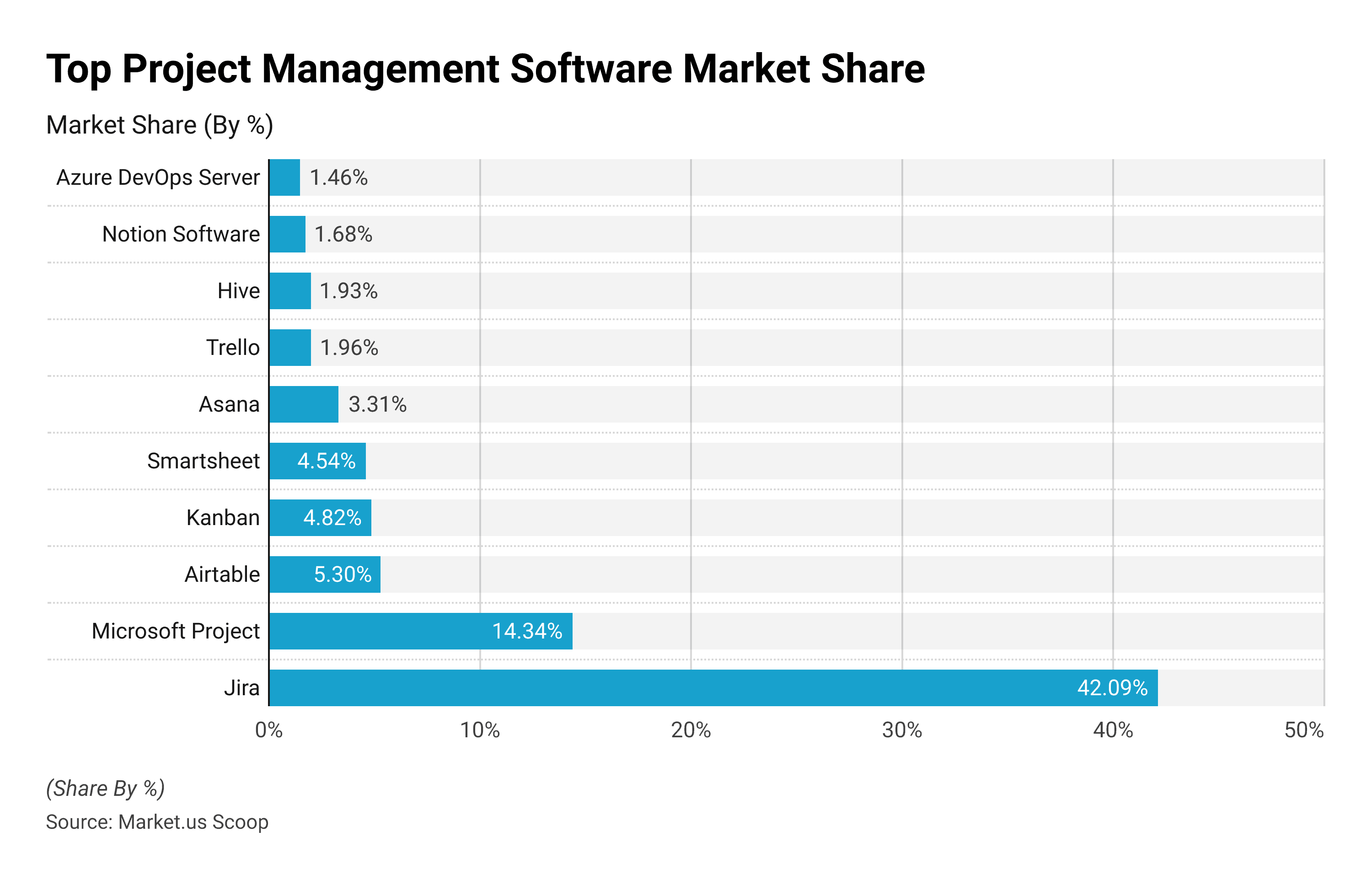
- The average manager saves 153 hours per year using project management software.
Management statistics show that project management software prevents the average manager from 10 minutes per day. These ten minutes add rapidly, saving a whopping 153 hours per year. While many managers argue that investing in PM software is not worth it due to the high costs, the benefits will probably outweigh the costs.
(Source: Workzone)
- According to a project management survey, 89% of project managers say their organization uses hybrid project management practices.
Traditional and agile methodologies are commonly thought to be opposed approaches that compete with one another, but we’re here to tell you that’s not the case.
You can have both — agile flexibility and traditional dependability. Combining these two allows you to develop a tailored approach for each project and increase project success rates.
(Source: Project Management Institute)
- Standardized project management practices are used to some extent by 93% of organizations.
Developing project management practices is a top priority for all project managers since they are the key to better and more efficient performance. Investing in these practices can save 28 times more money for companies.
(Source: Project Management Institute)
- Risk management practices are some of the most commonly employed by project managers.
According to Project Management Institute research, 26% of organizations ‘always’ use risk management practices, 34% use it ‘often,’ and only 3% of surveyed organizations ‘never’ use it.
- PRINCE2 is the most popular project management technique among project managers.
Following project management statistics, the most popular techniques used by project managers include integrated project management, hybrid, agile, and waterfall. PRINCE2 is at the opposite end of the spectrum, with only 5% of companies using it.
(Source: Capterra)
Most Desired Project Management Tool Feature
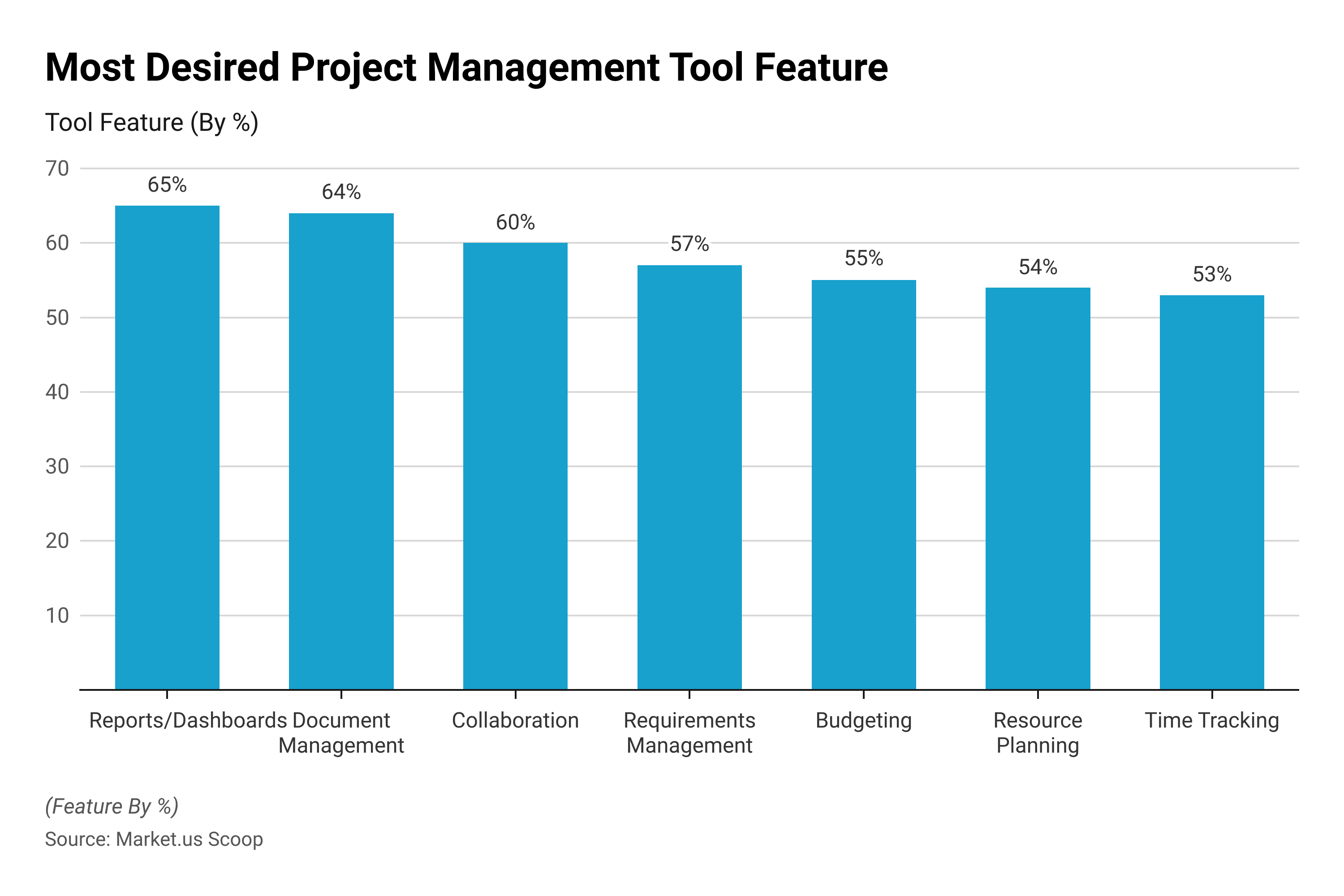
- 61% provide ongoing project-management training.
PMP certification and training are becoming increasingly popular with executives. The benefits of training in project management are many – they range from better efficiency to time management.
(Source: Project Management Institute)
- Over half of the companies want project professionals certified to play their roles.
The most common certification in project management is PMP, according to statistics. Other popular certificates include PRINCE2, SAFe CAPM, ITL, and CAPM. The certificates are different depending on which industry you work in, and certain jobs may not require certification. If you want to progress in your career, a certificate is essential.
(Source: Project Management Institute)
Project Failure Statistics
- 39% of projects fail due to poor planning.
39% of projects fail due to insufficient planning. Poor project planning can be disastrous, resulting in high costs and time delays.
(Source: TeamGantt, Research Gate)
- Almost 20% of IT initiatives might fail so poorly that they can constitute a danger to a company’s existence.
66% of IT projects fail partially or fully. You’re undoubtedly asking why technology initiatives fail so often and at such an incredibly high rate – the solution is lousy project management. Project failure is exacerbated by a lack of proper planning, poor communication, and poorly defined goals.
- According to statistics, IT projects fail in a range of 5% to 15%.
There are many reasons why IT projects fail. Project management is the most influential factor in project success or failure. Many organizations have realized the importance of project management and are now implementing it.
(Source: Gallup)
- The average budget overrun in IT projects is 27 percent.
Poor project management is expensive, particularly in the IT sector. These cost overruns affect national economies as well. Statistics on project management failures show that IT program failures cost the global economy $6.2 trillion per year.
(Source: Gallup, ZDNet)
- The project management software increases team communication by 52 %.
Poor communication is responsible for 30% of project failures. Project management software can almost eliminate ineffective communication, despite the wide range of reasons for project failure. You should be aware that 66% of organizations use project-management software to communicate with their clients.
(Source: Wrike)
Project Management Success
- BPM software can increase the success rate of projects by 70%.
A research grant, examined 150 BPM projects and found 95% were successful. BPM software eliminates bottlenecks, the nightmare of any project manager.
(Source: Process Street)
- 89% of high-performing firms tend to complete their projects successfully.
Low-performing firms only complete 36 % of their projects, compared to companies with high performance. According to statistics on project management success, 60% of companies believe that defined processes and practices are the keys to success.
(Source: Project Management Institute, Woodlande)
- A PwC study found that 97% of respondents believe project management is crucial to the growth and progress of their company.
Most projects are complex, requiring careful planning, organization, and monitoring. Project management ensures organizations have control and deliver outstanding results within project constraints.
(Source: Capterra)
Project Management Outlook
Experts predict that the demand for project managers will continue well into 2030. To address the talent shortage, two million project management roles need to be filled each year.
To improve their career prospects, those who wish to enter this field need to have a certification and a degree.
They should also have the mental strength to deal with job instability and other uncertainties. Statistics on construction project management revealed that the pandemic caused cancellations and delays. Hard and soft skills are equally important for project managers who will succeed despite challenges.
Project Management Job Outlook Statistics
- Based on the job profiles of 2021, there will be 603,120 Project Managers in the United States.
- The average project manager in the US is 46.6 years of age.
- 60% of US-based project managers are male, while only 36% are female.
- Between July 2020 and June 2021 in the United Kingdom, there will be 306,300 project managers who are experts in financial and business management. On the other side, there are 79.400 IT project and program managers, 64.800 construction project managers, and related professionals.
- 36% stay at their jobs for one or even two years. The other 18% stay between three and five years.
- Fortune 500 companies are the employers of 29% (of project managers) in the US. Other top employers included technology companies (15%). Finance companies (10%). Healthcare companies (6%), Telecommunications companies (5%).
- To meet the global talent demand by 2030, PMI estimates that 25 million people will need to be trained in project management.
- The talent gap will require 2.3 million people to enter the project management sector every year to close it.
- 61% of companies provide project management education, and 47% offer a career path that is well-defined for project professionals.
- In the last 12 months, one out of five project managers considered leaving their current job.
- According to PMI (2020), 51% of organizations require that project professionals have a certification.
(Source: Zippia 2021, Office for National Statistics 2020, PMI (2022,2021,2020), Girl’s Guide to Project Management)
Education and Salary Statistics
- Project Management Professionals (PMPs) earn median salaries that are 22% higher than those who do not hold PMP certification.
- According to Salary.com (2021), the average annual salary of a project manager was $68,188 in November 2021.
- 69% of US project managers have a Bachelor’s Degree. Meanwhile, 18% hold a master’s and 9% an associate degree. Only 1% of people have a Ph.D.
- The highest-paid project managers in the US are those with a doctoral level of education. The median annual income for these project managers was $121,283, compared to $113,249, for master’s degrees, and $102,040, for bachelor’s degrees.
- In Switzerland, the highest-paid project managers earn an average salary of $140.983. The lowest-paid professionals in project management are found in Pakistan, where their annual median salary is $13,803.
- In April 2020, 15% of construction projects either were canceled or delayed because of COVID-19.
(Source: PMI (2020,2021), Zippia 2021)
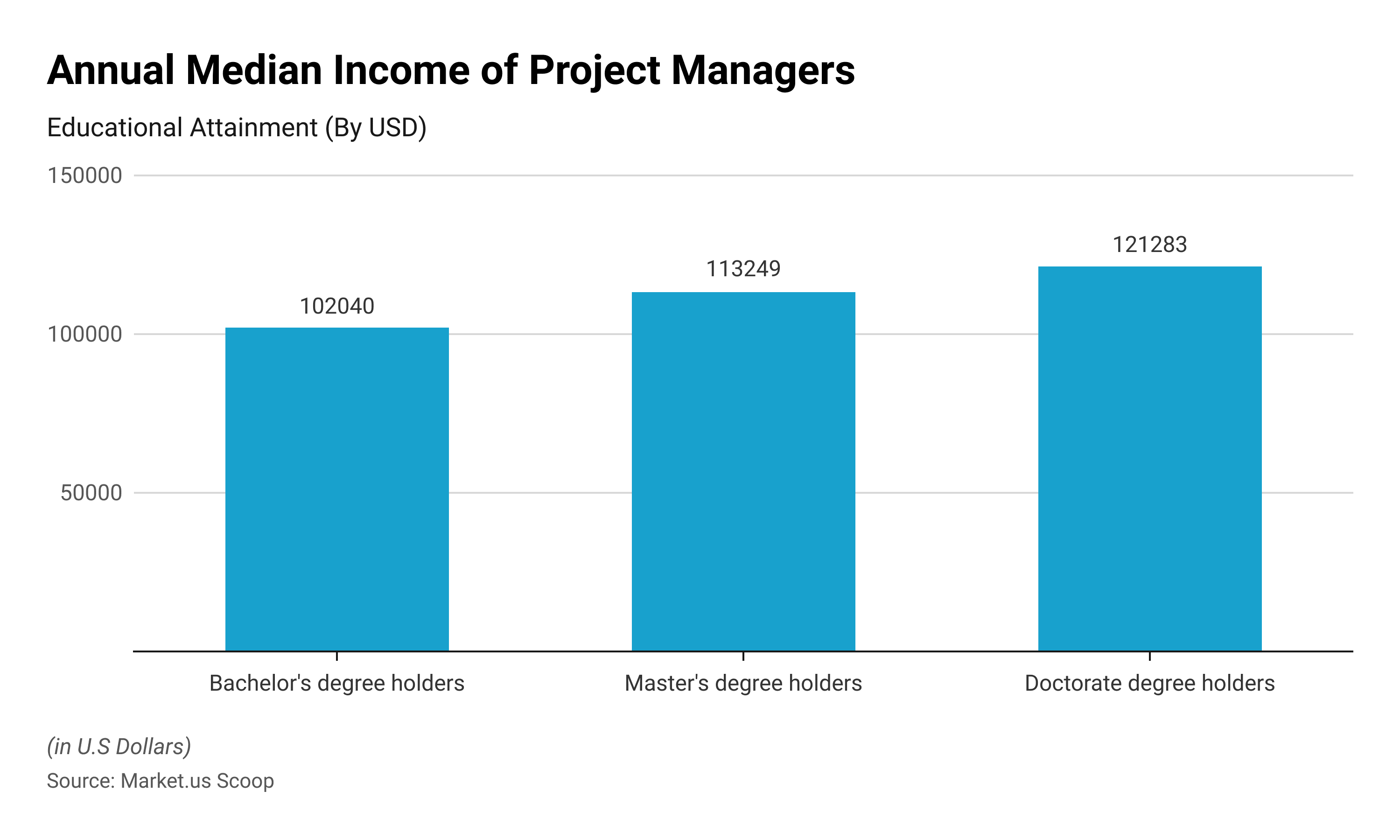
Most Popular Project Management Software
- Monday.com offers a visual platform to help teams plan, organize, monitor, and manage projects. Its intuitive and simple user interface allows for faster onboarding of your team. Our Monday.com product review will give you a full overview of its features.
- wrike a cloud collaboration and management software. It can provide real-time reporting and status updates for your projects. Wrike has many features that you can read about in our review.
- Smartsheet, a flexible project-management software, is suitable for any organization. The software has tools for planning, automating tasks, and producing reports to improve the efficiency of your team. Smartsheet has many features. Read our Smartsheet review to learn more.
- Asana helps you manage and track your projects all on one platform. It streamlines the communication in your organization. You can also set up goals with your colleagues. Asana’s review will give you more details.
- Jira was designed for developers’ teams who need to plan, track software releases, and manage their workflow. It allows you to design a custom workflow that is tailored to the needs of your team. Jira is a great tool. You can find out more in our Jira evaluation.
Key Statistics on Project Performance
According to industry experts, project management statistics reveal that a significant number of projects fail to deliver their full benefits and achieve success.
Only around one-third of organizations manage to meet their project deliverables within the scheduled timeframe.
Additional technology needs are the most common reason for projects exceeding their budgets. To make project management effective, organizations use different strategies like risk management, dedicated project management offices (PMOs), and technical skills development in employees.
Project Delivery Statistics
- According to a survey, 40% of companies claim that they consistently provide the complete project benefits.
- In Australia, more than half of organizations (51%) successfully complete projects that fulfill their business objectives or original goals. At the same time, slightly over half of organizations (52%) meet the needs of their stakeholders with their projects.
- Organizations that have strong project management abilities complete projects on schedule 63% of the time, while those with weaker abilities only meet deadlines 39% of the time.
- 47% of project management practitioners say that their companies have built a track record of project success.
- According to a recent survey, half of the participants attributed budget overages to the requirement for additional technologies. Other reasons included project scope expansion, underestimated project staffing, and technical, organizational, and data issues. All of these reasons were cited by 37.5% of participants.
- According to a survey, project delays in implementing ERP systems are often caused by organizational issues, followed by scope expansion and data issues. These three factors were found to be the biggest reasons for project delays, with 26.7% of respondents citing organizational issues as the top reason. In contrast, only 6.7% of respondents cited technical problems, unrealistic timelines, resource constraints, COVID-19, and other issues.
- 29% of organizations report that projects are mostly or always completed on time.
(Source: Wellingtone, 2020, KPMG, 2020, Panorama Consulting, 2020)
Project Delivery Best Practices
- 60% of project managers always or primarily engaged in some type of risk management.
- To support successful projects, 68% of organizations prioritize technical skills in talent development, while 65 percent prioritize leadership skills.
- Annually, approximately 36% of project management professionals spend one or more days compiling project reports.
- 89% of companies have at least two PMOs, with half having multiple ones.
- Wellingtone (2020) reports that 26% of PMOs are less than a two-year-old.
- The Scaled Agile Framework is the most widely used scaling strategy, with 37% of enterprises implementing it.
- The majority of project managers (59%) manage two to five projects at the same time. 15% work on only one project, while the remaining 15% work on more than ten. Meanwhile, only 11% manage six to ten projects concurrently.
(Source: Wellingtone, PMI, Digital.ai, Girl’s Guide to Project Management)
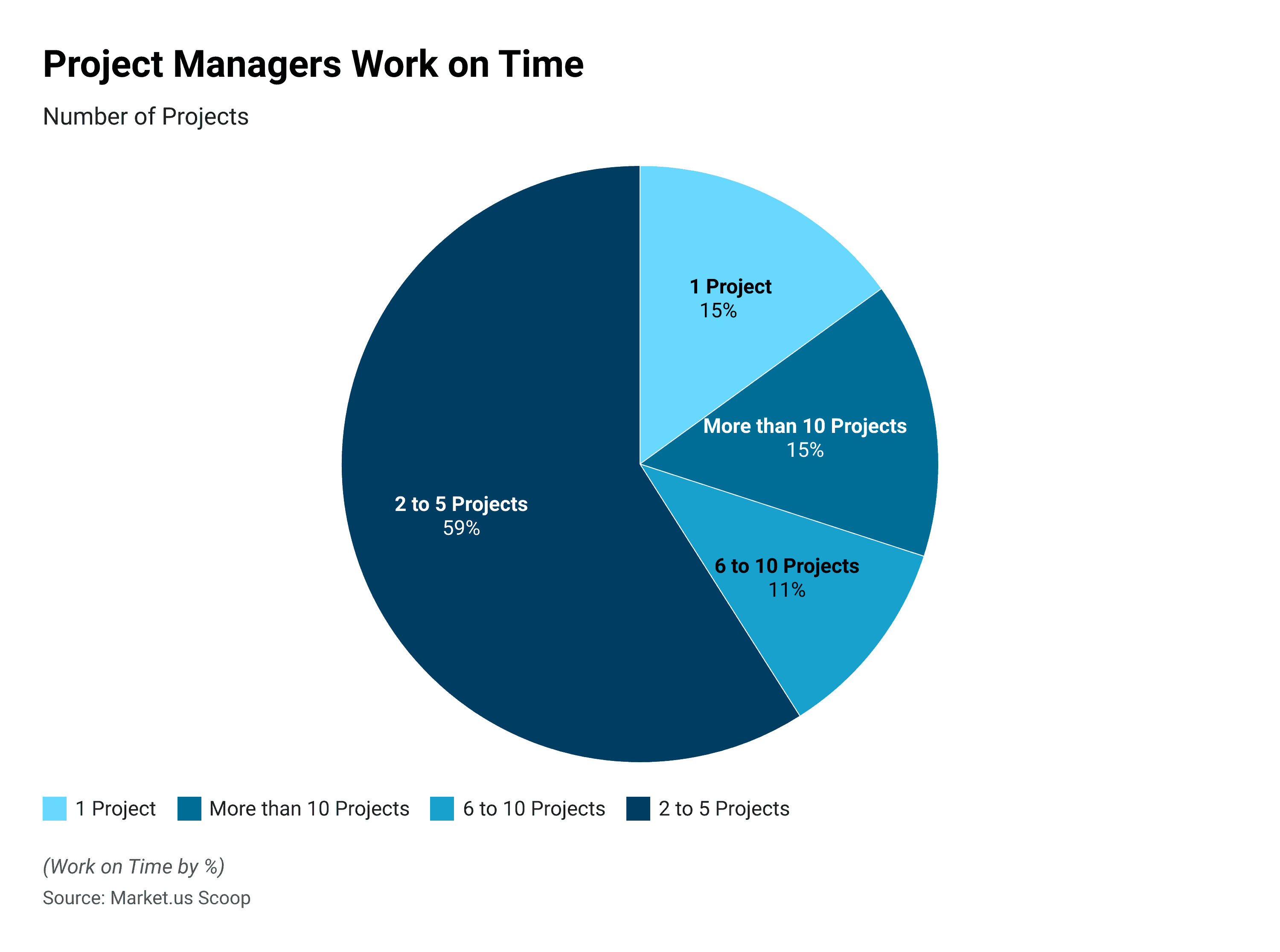
Project Failure and Management Challenges
- If management needs more than five hours when making choices, agile initiatives fail at a rate of 22%.
- 58% of project managers in Australia reported that the pandemic had a moderate or severe impact on projects and caused delays in projects and work programs.
- 25% of organizations often or never prepare scoping documents for initiatives.
- Project failure rates are 21% in organizations with poor value delivery maturity. In contrast, organizations with highly valuable delivery maturity have an unsuccessful rate of 11%.
- Even though this duty accounts for 20% of their work time, 25% of firms lack the necessary team collaboration tools.
- The most significant barriers to implementing agile methodologies in a business include inconsistent processes and practices (46%), cultural incompatibilities (43%), and overall organizational resistance to change (42%).
- In companies that have inadequate project management technology maturity, 46% of projects go over budget.
- 47% of agile tasks are late, over budget, or result in dissatisfied clients. Furthermore, 11% of adaptable projects fail and deliver nothing.
(Source: Scrum, KPMG, Wellingtone, PMI)
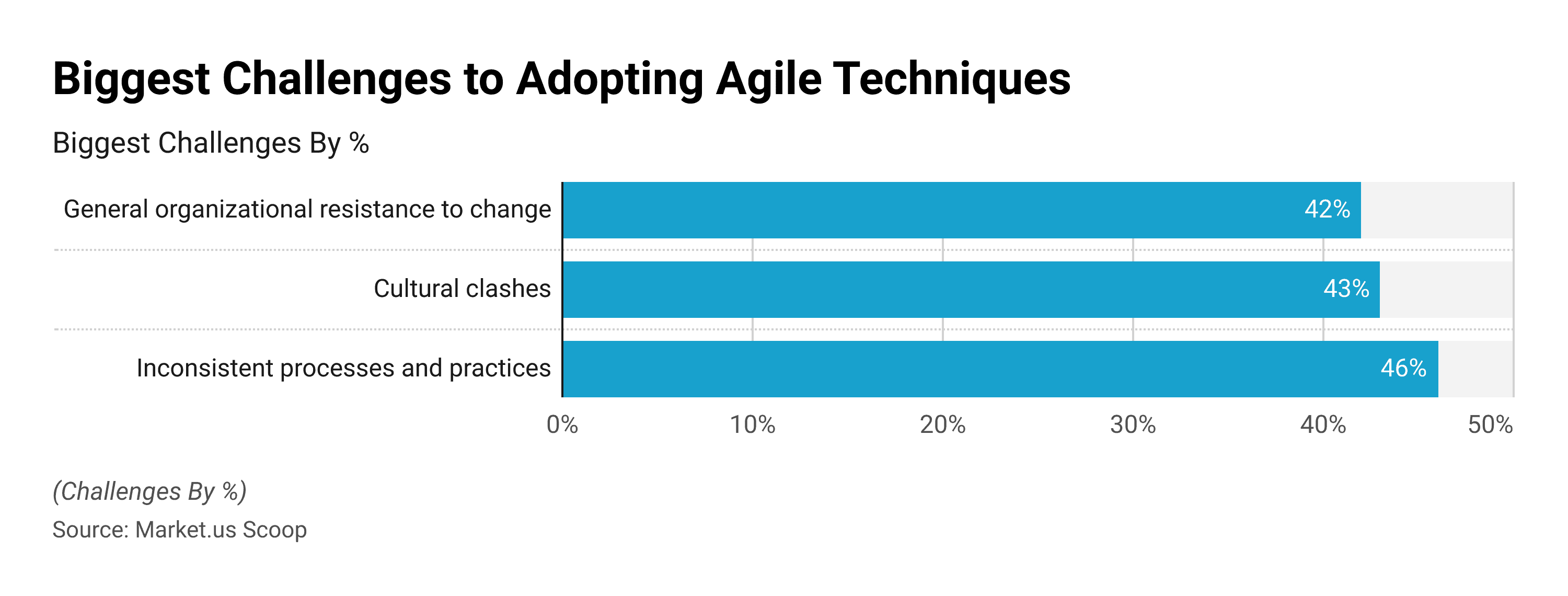
Project Management Software
Only around a third of firms employ project management software, with a sizable proportion using Excel for resource planning.
The majority also stated that they lack appropriate team collaboration technologies. However, given the modern workplace’s present direction, many firms are struggling to keep up with digital transformation.
As a result, industry statistics show that the vast majority of businesses have initiatives in place to support artificial intelligence and agile practices. They also frequently utilize task managers to track work connected to product development.
Project Management Software Key Developments
- 56% of firms have already implemented a digital transformation approach that includes AI.
- Organizations estimate that AI will mostly replace the jobs of project manager assistant (52%), project manager adviser (42%), and project manager substitute (3%).
- 52% of firms indicate a majority or all of their company’s teams have implemented agile methodologies.
- 75% of project professionals expect that the use of collaboration technologies for teams will expand in the future.
- 35% of executive leaders regarded organizational agility as the most important key to achieving future success.
- According to 32% of executive leaders, selecting the right technologies ranks as one of the top three most important factors in their future achievement.
- 31% of executive leaders feel that gaining applicable skills is one of the top three major elements in future success.
- Creating a culture that concentrates on providing customer value is a high priority for 70% of companies.
- 92% of tasks monitored by project managers were connected to product development. Other task types categories involve engineering (88%), marketing (48%), activities (44%), and sales (21%).
- 60% of teams use Slack or Google Workspace to collaborate but don’t have access to their assigned tasks.
- 75% of people use email to communicate with others on a team. In the meantime, 68% use phone conferencing, 2/59% use online collaborative tools, and 38% use a project management platform.
- 44% of people do not use project or task administration software to keep obligations apparent.
(Sources: IPMA, Digital.ai, Wellingtone, PMI, Cord, Project. co)
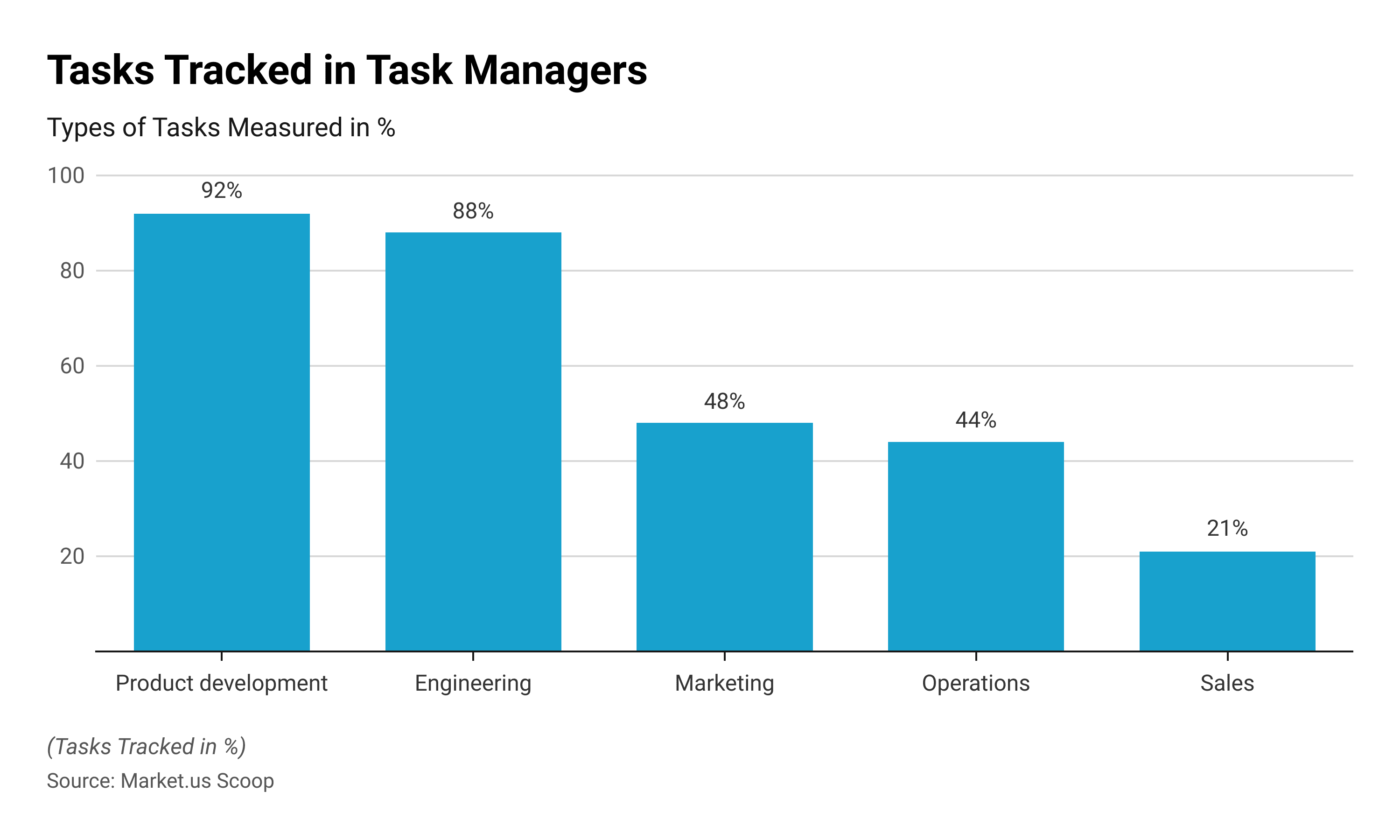
Recent Developments
Role in Mergers and Acquisitions:
- Project managers are critical in mergers and acquisitions, handling due diligence, integration plans, and maintaining stakeholder relationships to ensure smooth transitions and value creation from these transactions.
New Product Development:
- In product development, project managers are essential in coordinating between design, development, and marketing teams to ensure successful product launches. They manage tasks from initial design feedback to final testing and commercialization.
Technological Advancements:
- The integration of AI and machine learning in project management tools is enhancing forecasting accuracy, risk management, and resource allocation, making the planning and execution phases more efficient.
Expansion of Agile Methodologies:
- The Agile methodology continues to spread beyond software development into other areas such as marketing and product development, emphasizing flexibility, continuous improvement, and customer satisfaction.
Increased Focus on Remote Project Management:
- With the rise of remote work, there is a growing demand for project management tools and strategies that support distributed teams.
- This includes the development of mobile-accessible project management applications that facilitate collaboration and communication across different time zones and geographical locations.
Sustainability in Project Management:
- More companies are incorporating sustainability goals into their project management practices, assessing environmental impact, and utilizing green project management techniques to reduce carbon footprints and promote social responsibility.
Conclusion
Statistics on project management software and industry news from professionals provide unique insights into the market.
One of these is that, despite high levels of project management maturity and team collaboration, much remains to be desired.
Furthermore, less than half of businesses are capable of delivering project value and completing projects on schedule.
Regardless, project managers have used agile approaches and change management to reduce delays and manage risks.
Even with the projected talent deficit for project management roles, a well-balanced blend of hard and soft skills should make project management professionals marketable to employers as they develop into the role.
Sifting through industry data to uncover patterns may be additional work for project managers. Taking that extra step, however, may be worthwhile as they discover fresh ideas to apply to real-life scenarios to improve processes or boost the likelihood of project success.
Aside from applying industry knowledge, having the best online project management tools at one’s disposal is essential for staying ahead of the competition.
FAQ’s
Project management is the discipline of planning, organizing, and managing resources to successfully achieve specific goals and objectives within a defined timeframe. It involves initiating, planning, executing, monitoring, controlling, and closing a project.
The key components of a project include scope, time, cost, quality, resources, communication, risk, and stakeholders. These elements need to be effectively managed throughout the project lifecycle.
A project manager is responsible for overseeing the entire project from start to finish. Their role includes defining project objectives, creating a project plan, managing resources, coordinating team members, monitoring progress, mitigating risks, and ensuring successful project delivery.
A project lifecycle represents the stages that a project goes through from initiation to completion. It typically includes phases such as initiation, planning, execution, monitoring and controlling, and closure. Different methodologies may have variations in the number or names of these phases.
A project is a temporary endeavor with a specific goal and set of deliverables, whereas a program is a collection of related projects managed in a coordinated manner to achieve broader organizational objectives.
Popular project management methodologies include Waterfall, Agile, Scrum, Kanban, Lean, PRINCE2, and PMBOK (Project Management Body of Knowledge).
Discuss your needs with our analyst
Please share your requirements with more details so our analyst can check if they can solve your problem(s)



